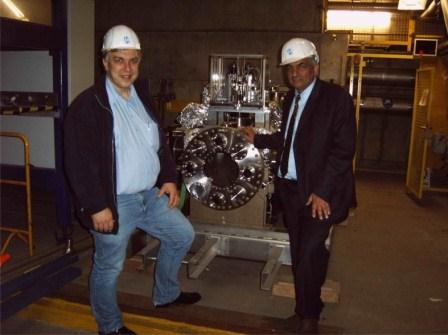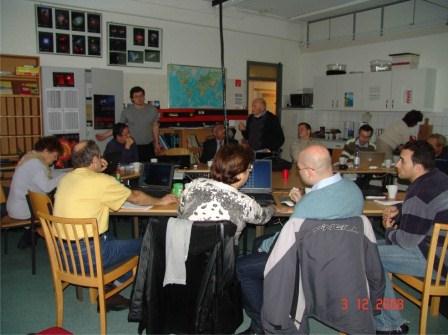
| 2008-12-15 04:38:16 |
Travel Report of A.Chilingarian, DESY, Hamburg, Kiel, Karlsruhe, Germany, 2- 12 December, 2008
On December 2 a meeting was held at DESY with the chairman of DESY board Albrecht Wagner and deputy research director Manfred Fleischer.
After discussions over the possible strategies of YerPhI development, Prof. Wagner agreed to be involved in the advisory board of Yerevan Physics Institute to review scientific directions of the institute.
After the examination of HERA-B detector we came to an agreement that CRD staff would participate in the detector dismounting (6 man-months) process, DESY would cover flight and leaving expenses and send the required equipmentand materials to CRD.

Figure 1. Manfred Fleischer and Ashot Chilingarian near HRA-B experiment target, DESY, 2 December 2008
The NMDB midterm meeting was held in Kiel on Decembe r3-5, 2008 at the Institute for Experimental and Applied Physics of the Christian-AlbrechtsUniversität zu Kiel.
On Wednesday, December 3, 2008, a scientific session was organized on the Neutron Monitor (NM) data quality control, particle data based forecasting and alerts where the Aragats group presented 2 reports:
- Median Filtering Algorithms for the Multichannel Detectors
- On the possibility to forecast severe radiation storms by data from surface and space-born facilities
The attention of NMDB collaboration was attracted to the new created SEVAN particle detectors’ networks. Parallely with the meeting, another group from YerPhI was installing SEVAN detectors in Bulgaria and Croatia. SEVAN detectors, simultaneously measuring charged and neutral fluxes of cosmic rays, have a serious advantage over neutron monitors and will be used both for the solar physics basic researches and the forecasting of geomagnetic and radiation storms, thus securing multibillion investments of people in space explorations.

Figure 2 Meeting of NMDB collaboration at the Christian-Albrechts-University at Kiel, December 4, 2008
On the second day the working packages 1-3 were reviewed. During the discussion of the new Data Acquisition (DAQ), registration electronics were recommended for the groups running neutron monitors, and several important issues were declared: the NKUA group plans to recommend PC- based DAQ electronics based on the PCI Advantech 1780 and 1710 cards. The 20 µs dead time is accepted as a standard by most of participants; if multiplicities are counted 1250 µs is used. The alternative embedded data acquisition electronics designed and fabricated by the CRD experts will also be in the list of the recommended DAQ systems.
The NMDB database acquires its shape and all the groups submit data to it. NMDB is created with MSQL 5.1 software and WEB pages of NMDB.eu are created under DRUPAL. NMDB educational site can share the same design, or be a separate page with its own design already prepared by the Aragats group.
The Armenian group (Aram Yeghikyan) will prepare a sophisticated front-end software for time series visualization and comparisons. The front-end software for the NMDB will be made by Aragats and Paris observatory groups independently. Both groups should communicate and coordinate activities with Athensand Oulu groups.
Works with the user tools are still in progress. Aragats group and IZMIRAN group work on the filtering algorithms to check possible mistakes in time series. Askar Ibragimov from Ouly group asked for simple filters for overall check of database. He also offered to provide a simple tool for updating the tables after filtering.
Training students and educational sections of project are very important and it’s planned to prepare lectures for students (to be send to Paris before March 1).
Euro-commissions offer to make an international meeting where participants from other continents will be invited to create global particle detector network. A new space weather initiative – space weather network will start operation. The NMDB next meeting is planned at ICRC in Lodz on July 5-12 where a room would be prepared for a half-day meeting with Maria Giller.
The NMDB school is planned for October-November, it may be held in Armenia (we should present the brochure and budget of the school), the final NMDB meeting will be on December 3-5 in Greece or Israel.
Lev Dorman informed that the final INTAS meeting will be in Israel on February 8-12, 2009. He also informed about kick-off meeting of the new COST Action ES0803 “Developing space weather products and services in Europe". The possibilities of CRD participation in this action should be urgently explored and appropriate letters written.
In Karlsruhe, during a meeting with CRD employees Suren Chilingarian and Aram Yegikyan, their working program for maintaining ADAS and DVIN software was detalized. The software designed by these software engineers is the crucial element of the ASEC data acquisition and presentation systems, enabling data transfer from the remote particle detectors located on the slopes of mountain Aragats and their presentation in the Internet.
Participation of the Aragats group in NMDB and project of the CRD prepared software planned for the SEVAN world-wide network, was also discussed. The software should be decentralized and democratic: each SEVAN node should have access to data from all SEVAN stations for data analysis and educational purposes.
Institute of Nuclear Physics of Karlsrue actively participates in the world biggest Cosmic Ray experiment – AUGER collaboration, located in Argentina. Recently AUGER started to produce very interesting results on nature and origin of the highest energy cosmic rays. AUGER results locate the highest cosmic rays origin in the galaxies hosted super-massive black holes and pointed on the weighting of the mass of CR nuclei with enlarging energy, i.e. highest energy cosmic rays are mostly iron nucleolus.
Its experimental motivation comes from analysis of the distribution of firs tinteraction height.
The mean value of the distribution for showers exceeding few units of 1019GeV is shifted to the values obtained from simulation of iron nuclei propagation in the atmosphere.
The variance of distribution also became smaller after 5x1018eV; it is also a feature inherent to the iron-initiated showers.
At the discussions with director of the Institute of electronics and data analysis of the Research center Karlsruhe, prof. Hartmut Gemmeke, we intended to start a network of FM antennas for solar radio-burst monitoring at Nor Amberd. The first 3 antennas will be installed (prof. Gemmeke will bring 2antennas to Armenia in May, 2009) and measurements will be started in summer 2009. Hardware (filters ADCs) will be prepared by CRD engineers, and the software library sent from Germany.
Prof. Gemmeke is famous in Germany for creating numerous highly successful commercial spin-offs in his institute. These small enterprises are manufactured services and products in different topics starting from tiny sensors till sophisticated medical equipments.
Prof. Gemmeke agreed to be on advisory board at YerPhI to help at establishing an innovation/commercialization program here.
Prof. Johannes Knapp from School of Physics & Astronomy University of Leeds also agreed to participate in the YerPhI advisory board. Prof.Knapp is an active member of world-biggest cosmic ray collaborations - AUGERand VERITAS, author of the CORSIKA code, widely used in CR community and editor of the ASTROPARTICLE physics journal.
